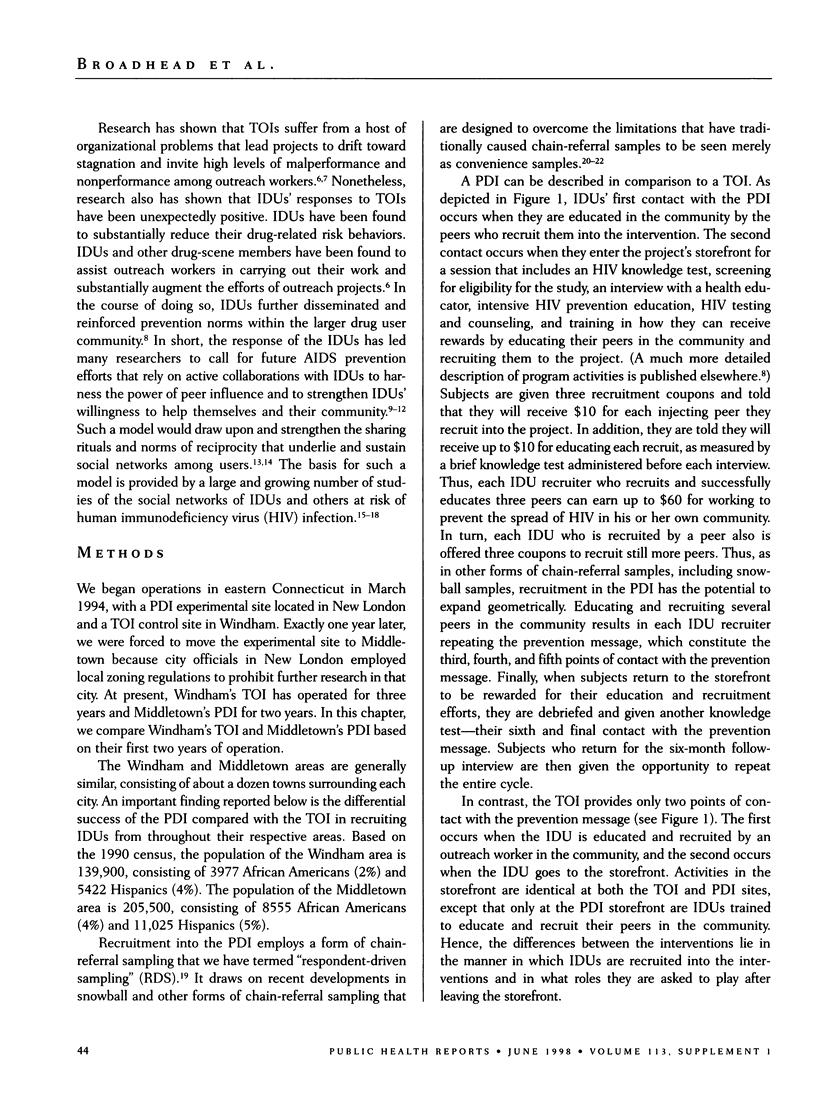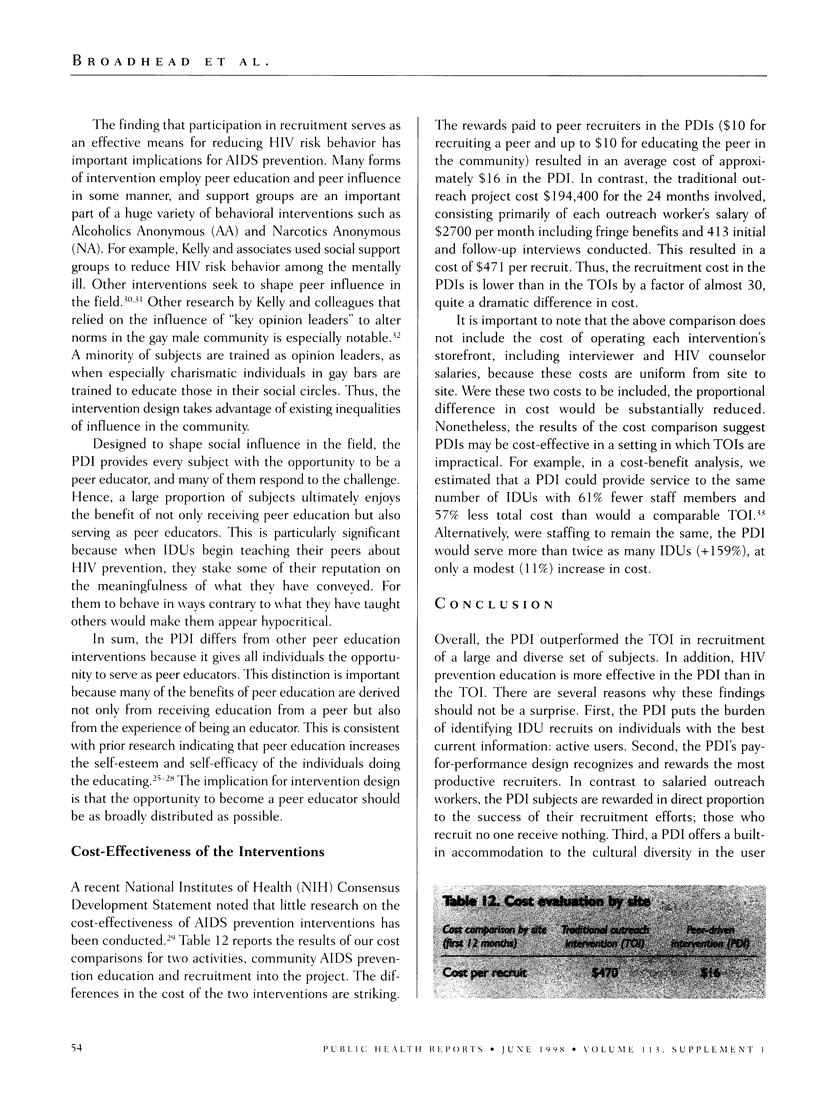Abstract
OBJECTIVE: Since 1985, community outreach efforts to combat acquired immunodeficiency syndrome (AIDS) among injecting drug users (IDUs) in the United States have overwhelmingly depended on a provider-client model that relies on staffs of professional outreach workers. We report on a comparison of this traditional outreach model with an innovative social network model, termed "a peer-driven intervention" (PDI). The latter provides IDUs with guidance and structured incentives that permit them to play a much more active role in the outreach process, thereby harnessing peer pressure on behalf of human immunodeficiency virus (HIV) prevention efforts. METHODS: We compare the performance of a traditional outreach intervention (TOI) and a PDI that were implemented in medium-sized towns in eastern and central Connecticut. Comparisons are based on the number and representativeness of IDUs recruited at each site, the effectiveness of HIV prevention education, compliance rates with AIDS risk reduction recommendations, and relative cost. The analyses are based on 522 initial interviews and 190 six-month follow-up interviews conducted during the first two years of each intervention's operation. RESULTS: Both interventions produced significant reductions in HIV risk behaviors, as measured using self-reports. The PDI outperformed the traditional intervention with respect to the number of IDUs recruited, the ethnic and geographic representativeness of the recruits, and the effectiveness of HIV prevention education. In addition, the costs of recruiting IDUs into the intervention and educating them about HIV in the community was only one-thirtieth as much in the PDI as in the traditional intervention. CONCLUSIONS: The findings suggest that given guidance and nominal incentives, IDUs can play a more extensive role in community outreach efforts than the traditional model allows. The findings also suggest that both interventions reduce HIV-associated risk behaviors, but the PDI reaches a larger and more diverse set of IDUs, and does so at much less expense.
Full text
PDF















Selected References
These references are in PubMed. This may not be the complete list of references from this article.
- Chitwood D. D., McCoy C. B., Inciardi J. A., McBride D. C., Comerford M., Trapido E., McCoy H. V., Page J. B., Griffin J., Fletcher M. A. HIV seropositivity of needles from shooting galleries in south Florida. Am J Public Health. 1990 Feb;80(2):150–152. doi: 10.2105/ajph.80.2.150. [DOI] [PMC free article] [PubMed] [Google Scholar]
- Des Jarlais D. C., Friedman S. R. Shooting galleries and AIDS: infection probabilities and 'tough' policies. Am J Public Health. 1990 Feb;80(2):142–144. doi: 10.2105/ajph.80.2.142. [DOI] [PMC free article] [PubMed] [Google Scholar]
- Fisher J. D., Fisher W. A. Changing AIDS-risk behavior. Psychol Bull. 1992 May;111(3):455–474. doi: 10.1037/0033-2909.111.3.455. [DOI] [PubMed] [Google Scholar]
- Kalichman S. C., Sikkema K. J., Kelly J. A., Bulto M. Use of a brief behavioral skills intervention to prevent HIV infection among chronic mentally ill adults. Psychiatr Serv. 1995 Mar;46(3):275–280. doi: 10.1176/ps.46.3.275. [DOI] [PubMed] [Google Scholar]
- Kelly J. A. HIV risk reduction interventions for persons with severe mental illness. Clin Psychol Rev. 1997;17(3):293–309. doi: 10.1016/s0272-7358(97)00020-2. [DOI] [PubMed] [Google Scholar]
- Kelly J. A., St Lawrence J. S., Betts R., Brasfield T. L., Hood H. V. A skills-training group intervention model to assist persons in reducing risk behaviors for HIV infection. AIDS Educ Prev. 1990 Spring;2(1):24–35. [PubMed] [Google Scholar]
- Klovdahl A. S., Potterat J. J., Woodhouse D. E., Muth J. B., Muth S. Q., Darrow W. W. Social networks and infectious disease: the Colorado Springs Study. Soc Sci Med. 1994 Jan;38(1):79–88. doi: 10.1016/0277-9536(94)90302-6. [DOI] [PubMed] [Google Scholar]
- Laumann E. O., Gagnon J. H., Michaels S., Michael R. T., Schumm L. P. Monitoring AIDS and other rare population events: a network approach. J Health Soc Behav. 1993 Mar;34(1):7–22. [PubMed] [Google Scholar]
- Miller T. E., Booraem C., Flowers J. V., Iversen A. E. Changes in knowledge, attitudes, and behavior as a result of a community-based AIDS prevention program. AIDS Educ Prev. 1990 Spring;2(1):12–23. [PubMed] [Google Scholar]
- Neaigus A., Friedman S. R., Curtis R., Des Jarlais D. C., Furst R. T., Jose B., Mota P., Stepherson B., Sufian M., Ward T. The relevance of drug injectors' social and risk networks for understanding and preventing HIV infection. Soc Sci Med. 1994 Jan;38(1):67–78. doi: 10.1016/0277-9536(94)90301-8. [DOI] [PubMed] [Google Scholar]


